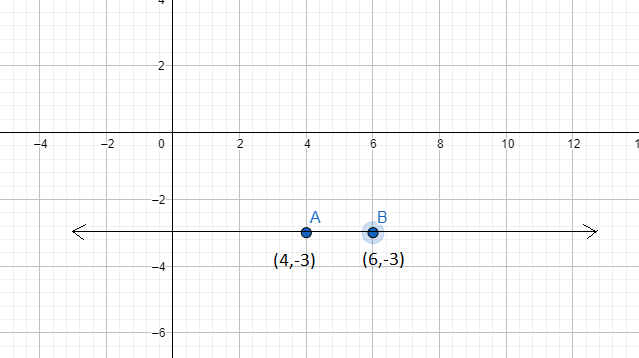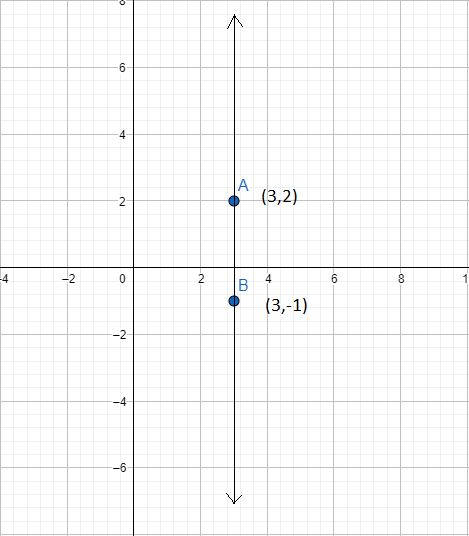Answer
451.8k+ views
Hint: We know that the slope of a line joining the two points \[\left( {{x}_{1}},{{y}_{1}} \right)\] and \[\left( {{x}_{2}},{{y}_{2}} \right)\] is equal to the tangent of the angle made by the line with x-axis in anticlockwise direction by as follows:
\[slope=\tan \theta =\dfrac{{{y}_{2}}-{{y}_{1}}}{{{x}_{2}}-{{x}_{1}}}\]
Complete step-by-step answer:
We will find the slope of a line passing through the following points as below:
(i) (-2, 3) and (8, -5)
We know that the slope of a line passing through the two points \[\left( {{x}_{1}},{{y}_{1}} \right)\] and \[\left( {{x}_{2}},{{y}_{2}} \right)\] is given by,
\[slope=\dfrac{{{y}_{2}}-{{y}_{1}}}{{{x}_{2}}-{{x}_{1}}}\]

So we have \[{{x}_{1}}=-2,{{y}_{1}}=3,{{x}_{2}}=8,{{y}_{2}}=-5\]
\[\Rightarrow slope=\dfrac{-5-3}{8-(-2)}=\dfrac{-8}{8+2}=\dfrac{-8}{10}=\dfrac{-4}{5}\]
Hence the slope is equal to \[\left( \dfrac{-4}{5} \right)\].
(ii) (4, -3) and (6, -3)
We know that slope of a line passing through the points \[\left( {{x}_{1}},{{y}_{1}} \right)\] and \[\left( {{x}_{2}},{{y}_{2}} \right)\] is given by,
\[slope=\dfrac{{{y}_{2}}-{{y}_{1}}}{{{x}_{2}}-{{x}_{1}}}\]

So we have \[{{x}_{1}}=4,{{y}_{1}}= -3,{{x}_{2}}=6,{{y}_{2}}=-3\]
\[\Rightarrow slope=\dfrac{-3-(-3)}{6-4}=\dfrac{0}{2}=0\]
Since we know that if the slope of a line is equal to 0 means the line is parallel to x-axis.
Hence, slope is equal to zero.
(iii) (3, 2) and (3, -1)
We know that the slope of a line passing through the points \[\left( {{x}_{1}},{{y}_{1}} \right)\] and \[\left( {{x}_{2}},{{y}_{2}} \right)\] is given by,
\[slope=\dfrac{{{y}_{2}}-{{y}_{1}}}{{{x}_{2}}-{{x}_{1}}}\]

\[\Rightarrow slope=\dfrac{-1-2}{3-3}=\dfrac{-3}{0}=\infty (infinity)\]
Hence the slope is equal to infinity means the line is perpendicular to the x-axis.
Note: Substitute the value of \[{{x}_{1}},{{y}_{1}},{{x}_{2}},{{y}_{2}}\] in the formula very carefully because if you misplace it order then you will get the incorrect answer. Also, remember that the slope of a line is also equal to the tangent value of the angle by the line and the x-axis in anticlockwise direction with respect to x-axis.
\[slope=\tan \theta =\dfrac{{{y}_{2}}-{{y}_{1}}}{{{x}_{2}}-{{x}_{1}}}\]
Complete step-by-step answer:
We will find the slope of a line passing through the following points as below:
(i) (-2, 3) and (8, -5)
We know that the slope of a line passing through the two points \[\left( {{x}_{1}},{{y}_{1}} \right)\] and \[\left( {{x}_{2}},{{y}_{2}} \right)\] is given by,
\[slope=\dfrac{{{y}_{2}}-{{y}_{1}}}{{{x}_{2}}-{{x}_{1}}}\]

So we have \[{{x}_{1}}=-2,{{y}_{1}}=3,{{x}_{2}}=8,{{y}_{2}}=-5\]
\[\Rightarrow slope=\dfrac{-5-3}{8-(-2)}=\dfrac{-8}{8+2}=\dfrac{-8}{10}=\dfrac{-4}{5}\]
Hence the slope is equal to \[\left( \dfrac{-4}{5} \right)\].
(ii) (4, -3) and (6, -3)
We know that slope of a line passing through the points \[\left( {{x}_{1}},{{y}_{1}} \right)\] and \[\left( {{x}_{2}},{{y}_{2}} \right)\] is given by,
\[slope=\dfrac{{{y}_{2}}-{{y}_{1}}}{{{x}_{2}}-{{x}_{1}}}\]

So we have \[{{x}_{1}}=4,{{y}_{1}}= -3,{{x}_{2}}=6,{{y}_{2}}=-3\]
\[\Rightarrow slope=\dfrac{-3-(-3)}{6-4}=\dfrac{0}{2}=0\]
Since we know that if the slope of a line is equal to 0 means the line is parallel to x-axis.
Hence, slope is equal to zero.
(iii) (3, 2) and (3, -1)
We know that the slope of a line passing through the points \[\left( {{x}_{1}},{{y}_{1}} \right)\] and \[\left( {{x}_{2}},{{y}_{2}} \right)\] is given by,
\[slope=\dfrac{{{y}_{2}}-{{y}_{1}}}{{{x}_{2}}-{{x}_{1}}}\]

\[\Rightarrow slope=\dfrac{-1-2}{3-3}=\dfrac{-3}{0}=\infty (infinity)\]
Hence the slope is equal to infinity means the line is perpendicular to the x-axis.
Note: Substitute the value of \[{{x}_{1}},{{y}_{1}},{{x}_{2}},{{y}_{2}}\] in the formula very carefully because if you misplace it order then you will get the incorrect answer. Also, remember that the slope of a line is also equal to the tangent value of the angle by the line and the x-axis in anticlockwise direction with respect to x-axis.
Recently Updated Pages
Mark and label the given geoinformation on the outline class 11 social science CBSE

When people say No pun intended what does that mea class 8 english CBSE

Name the states which share their boundary with Indias class 9 social science CBSE

Give an account of the Northern Plains of India class 9 social science CBSE

Change the following sentences into negative and interrogative class 10 english CBSE

Advantages and disadvantages of science

Trending doubts
Difference between Prokaryotic cell and Eukaryotic class 11 biology CBSE

Which are the Top 10 Largest Countries of the World?

Fill the blanks with the suitable prepositions 1 The class 9 english CBSE

Differentiate between homogeneous and heterogeneous class 12 chemistry CBSE

Difference Between Plant Cell and Animal Cell

10 examples of evaporation in daily life with explanations

Give 10 examples for herbs , shrubs , climbers , creepers

Write a letter to the principal requesting him to grant class 10 english CBSE

How do you graph the function fx 4x class 9 maths CBSE



